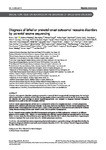Diagnosis of lethal or prenatal‐onset autosomal recessive disorders by parental exome sequencing
| dc.contributor.author | Stals, Karen | |
| dc.contributor.author | Wakeling, M | |
| dc.contributor.author | Baptista, Julia | |
| dc.contributor.author | Caswell, R | |
| dc.contributor.author | Parrish, A | |
| dc.contributor.author | Rankin, J | |
| dc.contributor.author | Tysoe, C | |
| dc.contributor.author | Jones, G | |
| dc.contributor.author | Gunning, AC | |
| dc.contributor.author | Lango Allen, H | |
| dc.contributor.author | Bradley, L | |
| dc.contributor.author | Brady, AF | |
| dc.contributor.author | Carley, H | |
| dc.contributor.author | Carmichael, J | |
| dc.contributor.author | Castle, B | |
| dc.contributor.author | Cilliers, D | |
| dc.contributor.author | Cox, H | |
| dc.contributor.author | Deshpande, C | |
| dc.contributor.author | Dixit, A | |
| dc.contributor.author | Eason, J | |
| dc.contributor.author | Elmslie, F | |
| dc.contributor.author | Fry, AE | |
| dc.contributor.author | Fryer, A | |
| dc.contributor.author | Holder, M | |
| dc.contributor.author | Homfray, T | |
| dc.contributor.author | Kivuva, E | |
| dc.contributor.author | McKay, V | |
| dc.contributor.author | Newbury‐Ecob, R | |
| dc.contributor.author | Parker, M | |
| dc.contributor.author | Savarirayan, R | |
| dc.contributor.author | Searle, C | |
| dc.contributor.author | Shannon, N | |
| dc.contributor.author | Shears, D | |
| dc.contributor.author | Smithson, S | |
| dc.contributor.author | Thomas, E | |
| dc.contributor.author | Turnpenny, PD | |
| dc.contributor.author | Varghese, V | |
| dc.contributor.author | Vasudevan, P | |
| dc.contributor.author | Wakeling, E | |
| dc.contributor.author | Baple, EL | |
| dc.contributor.author | Ellard, S | |
| dc.date.accessioned | 2022-05-03T17:54:00Z | |
| dc.date.available | 2022-05-03T17:54:00Z | |
| dc.date.issued | 2018-01 | |
| dc.identifier.issn | 0197-3851 | |
| dc.identifier.issn | 1097-0223 | |
| dc.identifier.uri | http://hdl.handle.net/10026.1/19160 | |
| dc.description.abstract |
<jats:title>Abstract</jats:title><jats:sec><jats:title>Objective</jats:title><jats:p>Rare genetic disorders resulting in prenatal or neonatal death are genetically heterogeneous, but testing is often limited by the availability of fetal DNA, leaving couples without a potential prenatal test for future pregnancies. We describe our novel strategy of exome sequencing parental DNA samples to diagnose recessive monogenic disorders in an audit of the first 50 couples referred.</jats:p></jats:sec><jats:sec><jats:title>Method</jats:title><jats:p>Exome sequencing was carried out in a consecutive series of 50 couples who had 1 or more pregnancies affected with a lethal or prenatal‐onset disorder. In all cases, there was insufficient DNA for exome sequencing of the affected fetus. Heterozygous rare variants (MAF < 0.001) in the same gene in both parents were selected for analysis. Likely, disease‐causing variants were tested in fetal DNA to confirm co‐segregation.</jats:p></jats:sec><jats:sec><jats:title>Results</jats:title><jats:p>Parental exome analysis identified heterozygous pathogenic (or likely pathogenic) variants in 24 different genes in 26/50 couples (52%). Where 2 or more fetuses were affected, a genetic diagnosis was obtained in 18/29 cases (62%). In most cases, the clinical features were typical of the disorder, but in others, they result from a hypomorphic variant or represent the most severe form of a variable phenotypic spectrum.</jats:p></jats:sec><jats:sec><jats:title>Conclusion</jats:title><jats:p>We conclude that exome sequencing of parental samples is a powerful strategy with high clinical utility for the genetic diagnosis of lethal or prenatal‐onset recessive disorders. © 2017 The Authors Prenatal Diagnosis published by John Wiley & Sons Ltd.</jats:p></jats:sec> | |
| dc.format.extent | 33-43 | |
| dc.format.medium | Print-Electronic | |
| dc.language | en | |
| dc.language.iso | eng | |
| dc.publisher | Wiley | |
| dc.subject | Congenital Abnormalities | |
| dc.subject | Female | |
| dc.subject | Genes, Recessive | |
| dc.subject | Genetic Diseases, Inborn | |
| dc.subject | Humans | |
| dc.subject | Male | |
| dc.subject | Parents | |
| dc.subject | Pregnancy | |
| dc.subject | Prenatal Diagnosis | |
| dc.subject | Exome Sequencing | |
| dc.title | Diagnosis of lethal or prenatal‐onset autosomal recessive disorders by parental exome sequencing | |
| dc.type | journal-article | |
| dc.type | Journal Article | |
| plymouth.author-url | https://www.webofscience.com/api/gateway?GWVersion=2&SrcApp=PARTNER_APP&SrcAuth=LinksAMR&KeyUT=WOS:000425644300006&DestLinkType=FullRecord&DestApp=ALL_WOS&UsrCustomerID=11bb513d99f797142bcfeffcc58ea008 | |
| plymouth.issue | 1 | |
| plymouth.volume | 38 | |
| plymouth.publication-status | Published | |
| plymouth.journal | Prenatal Diagnosis | |
| dc.identifier.doi | 10.1002/pd.5175 | |
| plymouth.organisational-group | /Plymouth | |
| plymouth.organisational-group | /Plymouth/Faculty of Health | |
| plymouth.organisational-group | /Plymouth/Faculty of Health/Peninsula Medical School | |
| plymouth.organisational-group | /Plymouth/Users by role | |
| plymouth.organisational-group | /Plymouth/Users by role/Academics | |
| dc.publisher.place | England | |
| dcterms.dateAccepted | 2017-10-23 | |
| dc.identifier.eissn | 1097-0223 | |
| dc.rights.embargoperiod | Not known | |
| rioxxterms.versionofrecord | 10.1002/pd.5175 | |
| rioxxterms.licenseref.uri | http://www.rioxx.net/licenses/all-rights-reserved | |
| rioxxterms.licenseref.startdate | 2018-01 | |
| rioxxterms.type | Journal Article/Review |


